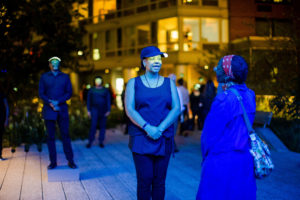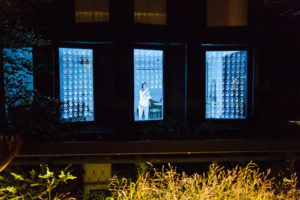Walking into The Mile-Long Opera by David Lang, I thought I knew what opera is. Well, the definition didn’t change. But the piece, performed last week on New York’s elevated walkway known as The High Line, changed the boundaries of opera, theater and artistic expression, and in ways that I couldn’t have imagined before taking the elevator up three floors and then trudging from 14th to 34th street.

This Pulitzer Prize-winning composer is making a life’s work out of writing music to be heard outside the typical venues and performance mechanisms, sometimes with outcomes that feel more like conceptual art than something musical for its own sake. His Lifespan had three singers blowing on a prehistoric rock suspended from the ceiling. Symphony for A Broken Orchestra was written for huge group playing fragmentary instruments from the Philadelphia school district that had been left for dead.
The Mile-Long Opera, performed Oct. 3-8, was nearly as unorthodox. It’s written for 1,000 choristers stationed along the High Line; they were divided into 26 sections, each one having a block of text that they spoke, chanted or sung in one of Lang’s pithy vocal fragments. The voices were never strictly coordinated, but they were organized enough to give the piece a sense of progressive movement; never was this the Tower of Babel. At times, you heard texts – usually about some aspect of New York life, culled or written by librettist Anne Carson – travel across the physical space as they were sung and repeated from singer to singer.
With the piece subtitled “a biography of 7 o’clock,” those texts revolved (more or less closely) around the hour of 7 pm, with poetic subjects like dusk as well as grittier stuff like a working-class dad coming home drunk and smacking the kids. Much of it felt like oral history of Manhattan’s Meatpacking District (where the High Line starts) in the years before it became a chic party central for young professionals.
Headings for the different sections had titles like “No, we don’t talk.” “I put on my makeup” “after rain,” “AMBER WILL YOU MARRY ME” and “coffee cups.” As a founding member of Bang on a Can, Lang naturally had at least some text in list form (which goes with the minimalist aesthetic). The most compelling went like this: “Funny how money changes everything. Funny how money changes nothing.” Substitute “money” for any number of things such as sex, hope, justice, drugs, no L train and you have gently lapping waves of accidental eloquence.
But there was nothing accidental or casual about the total package. Since the piece started around dusk (7 pm), the singers were illuminated by baseball caps whose visors contained a blue-ish light. At one turning point on the High Line, the singers had bags and back packs that were similarly illuminated from within.
In a bridge-like section where garden plants grow underneath the walkway, singers were stationed below you, so that you didn’t know where the sound was coming from Some of the office and residential buildings that the High Line so picturesquely weaves around had individual picture windows – distinctively lighted in a dusky blue – with window washers inside, some men, some women, all dressed casually and similarly.

(photo by Liz Ligon)
Sometimes the singers were spaced like a dispersed crowd, kind of at random, every two or three feet from each other. Near the end, singers were like sentries, spaced every ten feet long the walk way, then 15 feet, then 20 feet. At the very end, speakers placed at foot level emitted the only concerted choral music of the entire piece – a long delayed conversion of voices, as if you were finally hearing a huge choral work whose individual components had been laid out end-to-end along The High Line.
This touch was not something that showed listeners what they missed by not being at a conventional choral concert. In fact, I realized what I gained by not being at a such an event: A sense of one-on-one interaction with the singers. Many of them made serious eye contact with you as you walked by. One friend told me, “One fellow made such long, intense eye contact with me, I thought we would kiss. We didn’t.”
Some opted not to sing at all but to exclaim the text as if this was happening to them at that moment. You weren’t just hearing about New York life, but feeling it from those who seemed to be experiencing it first hand – and experiencing it in a way that, in my opinion, didn’t lend itself to a relay medium. The videos I’ve seen from The Mile-Long Opera didn’t come anywhere close to capturing what I experienced.
What made it an opera? Well, it had no plot – and many great ones don’t, like Postcards from Morocco – but there was a defined, well-cultivated narrative. No sustained characters were seen throughout the piece; in its place was a panorama of faces that you passed in the crowd The music and its presentation had well-calculated peaks and valleys as well as a long-term dramatic arc, sometimes afforded by the ebbing and flowing density of the music, sometimes with recurring texts that gave almost an arch-like shape to the overall piece.
The arrival of Heidi Waleson’s long-anticipated book about the demise of the New York City Opera – titled Mad Scenes and Exit Arias – has people thinking anew about what New York lost with this company that so consistently championed new work (though sometimes haphazardly). But is it possible that the absence of City Opera, between its 2013 bankruptcy and 2016 resurrection, created a space that far-more innovative operatic endeavors could fill? Now there’s much more site-specific stuff going on in places like the Green-Wood Cemetery catacombs (more on that later). Even City Opera is now presenting Astor Piazzolla’s tango-flavored Marie de Buenos Aires at (Le) Poisson Rouge, the popular downtown club. Would the company have been open to that before?
Lang has written numerous operas at this point, but few of them would’ve been suited to New York City Opera as it once stood, whether at Lincoln Center or City Center. Even discounting the unorthodox operatic mechanisms Lang’s pieces demand, would the so-called People’s Opera have been able to take Lang’s Anatomy Theater, which had a convicted criminal dissected onstage and then singing an aria after her stomach had been removed? And without Lang, think of how much more narrow our operatic boundaries would be. As he once said to me in a theater lobby, “There’s enough beauty in the world. There needs to be more weirdness.”
For the record: The Mile-Long Opera was co-created by Lang and Elizabeth Diller of Diller Scofidio + Renfro, the firm that designed the High Line. Co-producers were Diller Scofidio + Renfro, the High Line, and New York City’s Office of Performing Arts & Film. The directors were Elizabeth Diller and Lynsey Peisinger. Donald Nally (of The Crossing) was music director. Sound designer was Jody Elff.

